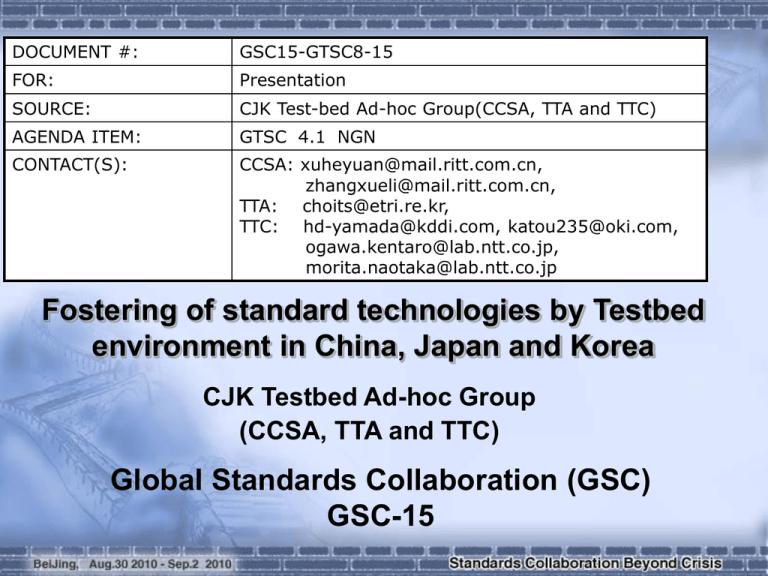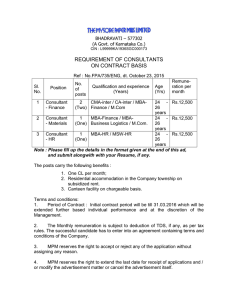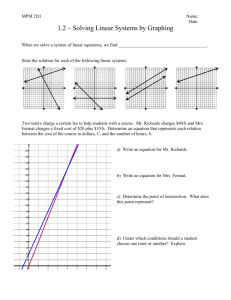DOCUMENT #: GSC15-GTSC8-15 FOR: Presentation
advertisement

DOCUMENT #: GSC15-GTSC8-15 FOR: Presentation SOURCE: CJK Test-bed Ad-hoc Group(CCSA, TTA and TTC) AGENDA ITEM: GTSC 4.1 NGN CONTACT(S): CCSA: xuheyuan@mail.ritt.com.cn, zhangxueli@mail.ritt.com.cn, TTA: choits@etri.re.kr, TTC: hd-yamada@kddi.com, katou235@oki.com, ogawa.kentaro@lab.ntt.co.jp, morita.naotaka@lab.ntt.co.jp Fostering of standard technologies by Testbed environment in China, Japan and Korea CJK Testbed Ad-hoc Group (CCSA, TTA and TTC) Global Standards Collaboration (GSC) GSC-15 Objectives of the CJK Testbed Demonstrate usefulness of standard or pre-standard technologies over the region-wide network environment among China, Japan, and Korea and contribute results and experiences to international standard activity to make standard specifications more practical. Collect best use cases and practices of standard technologies Prove and improve concepts of ongoing technologies in draft recommendations China Vendors Service Providers Vendors Operators Test-bed in China Korea Japan Service Providers Vendors Operators Test-bed in Japan Service Providers Operators Testbed in Korea Challenges and outputs The collaborative study framework has major advantages when conducting practical studies and developments of ITU Recommendations based on the relevant mid-and-long term leading edge trends in NGN technology. Several testing software tools and preliminary testing environments have been shared among CJK countries(SDOs). A part of those outputs is available to the people who interested in the similar studies and the investigations of specifications of ITU Recommendation provided as the out puts of our CJK Testbed studies. A current best practice and a practical proof of the specifications of ITU Rec. Shorten the lead times to develop the NGN system toward the market. Next steps If there are other SDOs who promote standard technologies by use of the Testbed style environment, CJK would like to share experiences. If experts in other SDOs are interested in tools of CJK Testbed, CCSA, TTA, and TTC are happy to talk with them. Subjects of the studies In order to investigate the technology integral to the worldwide services under the interconnected environment of the multiple NGNs owned by each country, we have been conducting both testbed studies and standardization studies in ITU-T involving China, Japan and Korea(CJK). Study 1: CCSA(CATR), TTA(ETRI), TTC(KDDI, OKI) Measurement and Evaluation of the quality of service (QoS) and the application layer quality (QoE; Quality of Experience) in order to control streams of the FMBC (Fixed Mobile & Broadcast Convergence) services based on the MPM (Management of Performance Measurement) functions. Study 2: CCSA(CATR), TTA(ETRI), TTC(NTT) To achieve requirements for transport stratum on an NGN, a functionally distributed transport networking (FDTN) architecture which divides the functions of transport stratum into the control element (CE), the forwarding element (FE) and the service element (SE) has been studied. Achievement of Study 1 A new recommendation ITU-T Y.2173 which defines specifications of the MPM functions was consented(SG13) based on the study 1. Overall architecture for NGN performance management Achievement of Study 2 A new supplement Y Sup.11 which describes application scenarios of the iSCP (independent scalable control plane, equivalent to FDTN) was approved based on the study 2. Management Plane Control Plane VNE CE CE SCE SCE ME FE FE Data Plane SPE SPE CE: Control Element SCE: Service Control Element FE: Forwarding Element SPE: Service Processing Element VNE: Virtual Network Element ME: Management Element Thank you for your attentions. CJK Testbed Ad-hoc Group Supplementary Slides 9 Network configuration of MPM study(Study 1) CJK Test-bed Testing scenarios of MPM study(Study 1) Performance Evaluation with RTP/RTCP-based Measurement extensions using the MPM (Management of Performance Measurement) functions. Supporting of multicast/unicast streams for Voice, Video, Audio and Concurrent (Multimodal) services Scenario 6-1: Performance evaluation of Network Segments Scenario 6-2: Performance evaluation of multimedia services among CPEs Local testing of MPM and CPE-to-CPE performance evaluations Scenario 6-3: Performance evaluation of multimedia services with two MPMs CPE – MPM1 – MPM2 – CPE performance evaluations Scenario 6-4: Performance evaluation of multimedia service with three MPMs CPE – MPM1 – MPM2 – MPM3 – CPE performance evaluations Scenario 7: Testing of RACF and RTP/RTCP-based MPM Interactions Schedule of MPM study(Study 1) Achievement of Study 1 (Cont’d) A new reference point called Rm between RACF and MPM in Rec. Y.2111 was added based on the study 1. Service Control Functions Service Stratum Transport Stratum Rs RACF Rd PD-FE Ru Management for Performance Measurement Rp Rm Rh CGPEFE CPN TRC-FE Rn Rc TRE-FE Rt Rw PE-FE Transport Functions Ri Other NGNs Network Attachment Control Functions Achievement of Study 1 (Cont’d) Development of a commercial MPM equipment based on Study1. • Traffic Monitoring/Analysis between separated Network using MPM functionality • Transcodec between Terminals in different Network Terminal B (ITU-T G.711) Korea Japan Terminal A (ITU-T G.722) China MPM equipment (Transcodec and Traffic Monitoring/Analysis) Terminal C (ITU-T G.711) Network configuration of FDTN study(Study 2) Control plane CE3 SE2 Korea Data plane VPN FE6 Feasibility test FE7 NCE CE2 Japan China VPN CE1 SE1 FE1 VPN FE2 VPN FE5 VPN FE3 Data sender FE4 Data sender • • • • • Normal operation Topology change CE failover SE failover Characteristics measurement - Re-routing delay - Communication delay - Failover delay Research overview of FDTN Study(Study 2) To achieve requirements for transport stratum on an NGN, we have proposed a functionally distributed transport networking (FDTN) architecture. • Network scalability for growing traffic • Easy to add new transport related services • Easy to control path according to a policy Control element (CE) is separated from forwarding element (FE) for independent scale up. Service element (SE) minimize development and introduction time & cost for new services. CE is separated to achieve service oriented network wide policy routing. AS division is very complex operation Existing transport network CE FE ★ CE FE CE ★FE CE ★FE CE FE ★ AS2 CE FE CE ★FE CE ★FE AS3-1 Functionally distributed transport network ★ AS3-2 CE CE FE FE FE FE FE CE CE CE ★ FE AS1 ★ FE CE ★ ★ AS1 All nodes need program upgrade to add new. functions CE FE FE FE FE CE FE FE CE SE FE FE ★ new CE SE FE FE FE FE FE FE FE Testing scenarios and schedule of FDTN study(Study 2) Checking feasibility on FDTN architecture under the international environment to confirm if the architecture can solve the problems of increasing network size on NGN. • Scenario 1 : Preparing and checking for test environments using international lines • Scenario 2 : Basic test for functionality check in CJK testbed between 2 countries • Scenario 3 : Basic test for functionality check in CJK testbed among 3 countries 2008 CJK NGN-WG meeting Test scenario 12th Japan 3/31-4/2 13th Korea 7/23-7/25 Preliminary experiment 2009 14th Japan 12/10-12/12 15th China 4/8-4/10 Scenario 1 Scenario 2 (J-K) 16th China 7/22-7/24 Scenario 2 (C-J) 2010 17th China 11/16-11/17 18th Korea 4/7-4/9 Scenario 3 (C-J-K)


